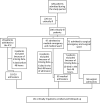Incidence and Predictors of Acute Kidney Injury Among Critically Ill Adult Patients Admitted at Mbarara Regional Referral Hospital
- PMID: 40635905
- PMCID: PMC12239920
- DOI: 10.2147/IJNRD.S524082
Incidence and Predictors of Acute Kidney Injury Among Critically Ill Adult Patients Admitted at Mbarara Regional Referral Hospital
Abstract
Background: Severely ill patients are vulnerable to developing Acute Kidney Injury (AKI), with variable incidence, but limited data from LMICs. We evaluated the incidence, predictors, treatment, and outcomes of AKI among very ill adult patients at a public tertiary hospital in southwestern Uganda.
Methods: This prospective cohort study categorized patients who had a NEWS-2 above 5 as critically ill. We used the "Kidney Disease Improving Global Outcomes (KDIGO)" definition of AKI as a 0.3 mg/dl increase in serum creatinine within 48 hours. Participants were followed up until day 7 of admission, death or discharge, whichever occurred first. STATA version 13 was used for data analysis. Predictors of AKI were determined by logistic regression.
Results: Of 161 critically ill patients, the median age was 48 years (IQR: 31-65). The incidence of AKI was 70 (95% CI 55-90) per 1000 person days of observation. About, 39.1% (127) drugs used during hospitalization were deemed potentially nephrotoxic, and 60% (96) of participants were exposed to at least one nephrotoxic drug. Penicillins and loop diuretics were the most commonly used nephrotoxic drugs. Predictors of AKI included: previous hospitalization in the last 3 months (aOR 2.56, 95% CI: 1.08-6.06, P=0.032), admission to the surgical ward (aOR 4.32, 95% CI: 1.22-15.24, P=0.023), elevated baseline creatinine (>1.2 mg/dl) (aOR 2.44, 95% CI: 1.13-5.27, P=0.023) and elevated baseline WBC count (>12 × 109/µL) (aOR 2.57, 95% CI: 1.21-5.46, P=0.014). Most AKI patients were managed conservatively; 25% of patients with stage 3 received hemodialysis, and 25% of those with incident AKI died in the hospital.
Conclusion: We found a high prevalence of AKI among critically ill patients (70 per 1000 person days). Previous hospitalization in the past 3 months, high baseline creatinine, high baseline WBC count and admission to the surgical ward were independently associated with AKI.
Keywords: Uganda; acute kidney injury; critically ill patients; nephrotoxic drugs; predictors.
© 2025 Muhindo et al.
Conflict of interest statement
The authors have no competing interests for this work.
Figures
References
-
- KDIGO. KDIGO clinical practice guideline for acute kidney injury. 2012:1–141.
-
- Chawla LS, et al. Acute kidney injury in critically ill patients. Clinical Journal of the American Society of Nephrology. 2014.
LinkOut - more resources
Full Text Sources
Miscellaneous




